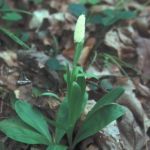| Common Name: |
False Unicorn Root |
| Other Names: |
Helonias, fairy wand, devil's bit |
| Botanical Name: |
Chamaelirium luteum syn. Helonias dioica |
| Genus: |
Chamaelirium |
| Family: |
Asteracea |
| Location: |
Eastern N. America |
| Cultivation: |
Moist to wet, well-drained, rich, neutral to acid soil in partial shade. |
| Propagation: |
By seed sown in autumn; by division in spring. |
| Harvest: |
Rhizomes with roots are lifted in autumn and dried for use in infusions, liquid extracts, tablets and tinctures. |
| Height: |
30-90cm (1-3ft) |
| Width: |
15-38cm (6-15in) |
| Hardiness: |
Z4 |
| Parts Used: |
Rhizomes, roots |
| Properties: |
An astringent, bitter, diuretic herb that acts mainly as an ovarian and uterine tonic. It expels intestinal worms. |
| Medicinal Uses: |
Internally for menstrual and menopausal complaints, infertility, pelvic inflammatory disease, endometriosis, fibroids, threatened miscarriage, and morning sickness. Excess causes vomiting. Often combined with Trillium erectum (See, bethroot). Also as a tonic for digestive and genito-urinary complaints, and to expel intestinal parasites. For use by qualified practitioners only. |
| Bibliography: |
Encylopedia of Herbs by Deni Brown Copyright ©: 1995, 2001 Dorling Kindersley Limited pg 164
|

